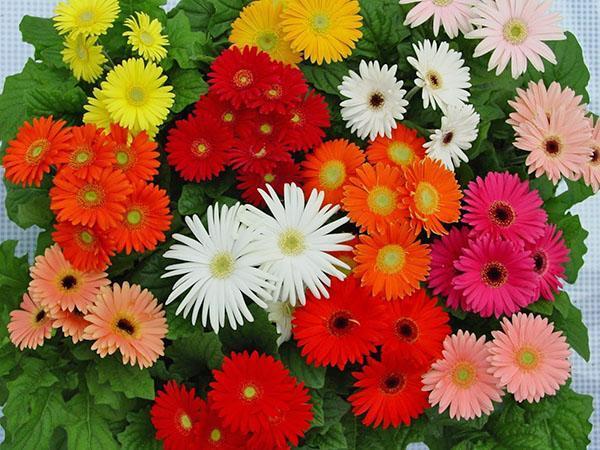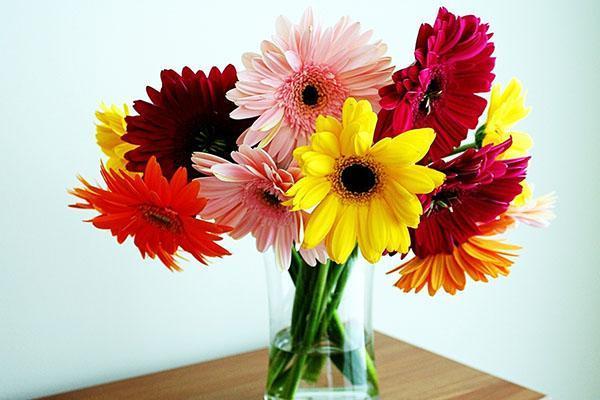Learn to grow an African beauty gerbera in the garden and in the room
 Gerberas are favorite plants of flower growers, and there are many confirmations of this. They bloom for a long time with fantastically clear and bright colors. In the palette of shades, only blue tones are missing (although it is easy to find them on sale). Beautiful large flowers with contrasting color centers rest on strong, long, bright green stems. Blooming flowers are extremely hardy and can stand in water for up to three weeks. All this makes the gerbera one of the best in the cut culture after roses, carnations, tulips and chrysanthemums... Many amateur and artistic photographs of gerberas confirm this fact.
Gerberas are favorite plants of flower growers, and there are many confirmations of this. They bloom for a long time with fantastically clear and bright colors. In the palette of shades, only blue tones are missing (although it is easy to find them on sale). Beautiful large flowers with contrasting color centers rest on strong, long, bright green stems. Blooming flowers are extremely hardy and can stand in water for up to three weeks. All this makes the gerbera one of the best in the cut culture after roses, carnations, tulips and chrysanthemums... Many amateur and artistic photographs of gerberas confirm this fact.
But in recent years, this bright beauty has become popular as a houseplant.
Description of the plant
 Gerbera belongs to the genus of perennial herbs from the Astrov family. Most of the species are native to Africa and tropical Asia. Her flowers look like a large chamomile and in the English-language literature they are called "transvaal chamomile". Elongated leaves are collected in a basal rosette. Peduncles are tall, strong, have no leaves.
Gerbera belongs to the genus of perennial herbs from the Astrov family. Most of the species are native to Africa and tropical Asia. Her flowers look like a large chamomile and in the English-language literature they are called "transvaal chamomile". Elongated leaves are collected in a basal rosette. Peduncles are tall, strong, have no leaves. Flowers are a basket inflorescence. Their sizes in some varieties reach 30 cm. Elegant giants bloom for 3-4 months. Seeds remain viable for a very short time - about 6 months, so when buying seeds, you need to monitor both the expiration date and the date of their collection.
Flowers are a basket inflorescence. Their sizes in some varieties reach 30 cm. Elegant giants bloom for 3-4 months. Seeds remain viable for a very short time - about 6 months, so when buying seeds, you need to monitor both the expiration date and the date of their collection.
How to grow a gerbera in a flower bed
 Growing a gerbera in the garden and caring for it is simple and fun, but requires compliance with the conditions necessary for a long and lush bloom.
Growing a gerbera in the garden and caring for it is simple and fun, but requires compliance with the conditions necessary for a long and lush bloom.
 In southern Russia, gerbera blooms from spring to autumn and hibernates without any problems without shelter. In the middle lane, the flowering will be more modest, and for the winter the gerbera will have to be dug up and stored with a lump of earth in a cool, dry place.
In southern Russia, gerbera blooms from spring to autumn and hibernates without any problems without shelter. In the middle lane, the flowering will be more modest, and for the winter the gerbera will have to be dug up and stored with a lump of earth in a cool, dry place.
In areas with mild warm winters, gerberas are covered with leaf litter and covering material, dispensing with digging.
Gerbera planting
 Planting and caring for a garden gerbera begins at the end of winter. The plant is grown in seedlings. Seeds are sown in seedling containers from January to March in a mixture of garden soil with sand and compost. The seeds are covered very shallowly, only slightly sprinkling with earth. Seedlings, as a rule, are uncooperative and appear in 10-12 days.
Planting and caring for a garden gerbera begins at the end of winter. The plant is grown in seedlings. Seeds are sown in seedling containers from January to March in a mixture of garden soil with sand and compost. The seeds are covered very shallowly, only slightly sprinkling with earth. Seedlings, as a rule, are uncooperative and appear in 10-12 days.
When sowing seeds for seedlings, it is necessary to take into account their low germination and increase the seeding rate.
 After the appearance of several true leaves, the sprouts are planted in boxes or immediately in separate pots. The lightest window sills are chosen for seedlings. Seedling care consists in regular moderate watering.
After the appearance of several true leaves, the sprouts are planted in boxes or immediately in separate pots. The lightest window sills are chosen for seedlings. Seedling care consists in regular moderate watering.  When watering, water should not fall into the root outlet, since the plant rots easily. Excessive watering threatens the appearance of thrips on the surface of the earth. In this case, both the plant and the soil surface are treated with Fitoverm.
When watering, water should not fall into the root outlet, since the plant rots easily. Excessive watering threatens the appearance of thrips on the surface of the earth. In this case, both the plant and the soil surface are treated with Fitoverm.
When propagated by seed, gerberas may not retain the color of their parent plants.
Outdoor Gerbera Care
 Gerbera seedlings are planted in open ground after the threat of frost disappears. This usually happens in the second half of May. Choose a sunny place for landing. The best soil for them is light, drained, with inorganic fertilizers applied.
Gerbera seedlings are planted in open ground after the threat of frost disappears. This usually happens in the second half of May. Choose a sunny place for landing. The best soil for them is light, drained, with inorganic fertilizers applied.  With an excess of organic matter in the ground, the peduncles are strongly stretched.Fading inflorescences must be removed in a timely manner. This stimulates the emergence of new ovaries. During active growth and flowering, the gerbera is watered abundantly, preventing water from entering the outlet. After flowering, the soil is moistened only after the earthen coma has dried.
With an excess of organic matter in the ground, the peduncles are strongly stretched.Fading inflorescences must be removed in a timely manner. This stimulates the emergence of new ovaries. During active growth and flowering, the gerbera is watered abundantly, preventing water from entering the outlet. After flowering, the soil is moistened only after the earthen coma has dried.
In autumn, the gerbera is covered or dug up with a clod of earth. The shelter is made dry and ventilated so that the flower does not rot during the thaw.
If there is a possibility of freezing, it is better to dig it up and store it in the basement or on a glazed veranda at a temperature of 7-8 ° C.
 In the spring, the gerbera is transferred to a pot that is suitable in size, transferred to a warmer and lighter place, and watering is increased. In late April - early May, an adult plant is planted in open ground.
In the spring, the gerbera is transferred to a pot that is suitable in size, transferred to a warmer and lighter place, and watering is increased. In late April - early May, an adult plant is planted in open ground.
Overwintered gerberas do not need to be transplanted to the flower bed. Leave them in pots to decorate seating areas, gazebos, verandas, porches. Without a transplant, plants get sick less and begin to bloom earlier. Do not forget to feed them with complex mineral fertilizers.
How to grow gerbera indoors
 For growing indoors, dwarf species of Jameson's gerbera are chosen. They are sold in bouquets in flower shops. Having received an adult gerbera plant from seeds at home through seedlings, it is kept on the east and west windows. On the south side, it is shaded at noon. For better flowering, they maintain a temperature of 22-24 ° C and try to prevent its strong drops in day and night values.
For growing indoors, dwarf species of Jameson's gerbera are chosen. They are sold in bouquets in flower shops. Having received an adult gerbera plant from seeds at home through seedlings, it is kept on the east and west windows. On the south side, it is shaded at noon. For better flowering, they maintain a temperature of 22-24 ° C and try to prevent its strong drops in day and night values.
 At the end of flowering, the plant is transferred to a cooler place. How to properly care for a gerbera in winter? During the dormant period, the plant needs coolness and very moderate watering... In cold weather, the flower needs additional lighting.
At the end of flowering, the plant is transferred to a cooler place. How to properly care for a gerbera in winter? During the dormant period, the plant needs coolness and very moderate watering... In cold weather, the flower needs additional lighting.
How to prolong flowering in a bouquet
 Having received a luxurious multi-colored bouquet as a gift, you probably wondered how to keep gerberas in a vase longer. In fact, cut gerbera is not capricious and phenomenally tenacious. Flowers can come to life, even if you had to walk with the bouquet all day.
Having received a luxurious multi-colored bouquet as a gift, you probably wondered how to keep gerberas in a vase longer. In fact, cut gerbera is not capricious and phenomenally tenacious. Flowers can come to life, even if you had to walk with the bouquet all day.  That is why they like to give gerbera compositions to brides - flowers will not lose their will to live for the whole day and will come to life before our eyes, if you put the ends of the stems in water and support heavy heads. For such a procedure, a lattice is suitable, through the cells of which the stems are passed.
That is why they like to give gerbera compositions to brides - flowers will not lose their will to live for the whole day and will come to life before our eyes, if you put the ends of the stems in water and support heavy heads. For such a procedure, a lattice is suitable, through the cells of which the stems are passed.
 To keep the bouquet in a vase, use the following guidelines:
To keep the bouquet in a vase, use the following guidelines:
- change the water every day;
- choose a tall and narrow vase so that the flowers do not bend under their own weight;
- pour water a few centimeters so that the stems do not rot;
- trim the softened ends of the stems before the next water change;
- cut the stems obliquely and make small punctures or longitudinal cuts at the bottom of the stem. This will help the water absorb better.
 Subject to these simple conditions, a gerbera bouquet will delight you with fresh and bright flowers for up to three weeks.
Subject to these simple conditions, a gerbera bouquet will delight you with fresh and bright flowers for up to three weeks.